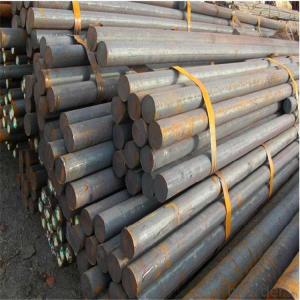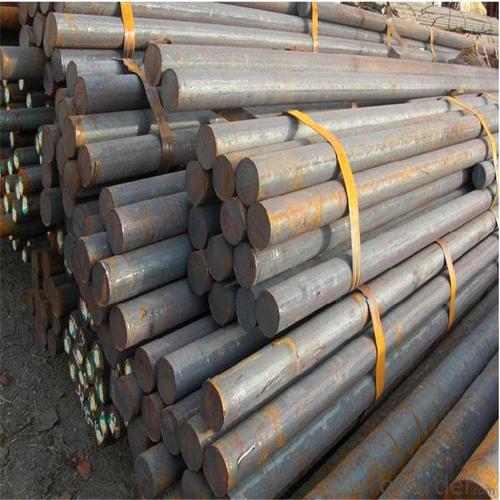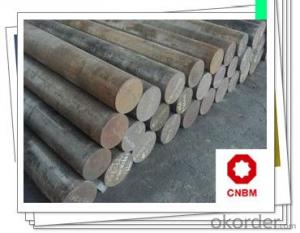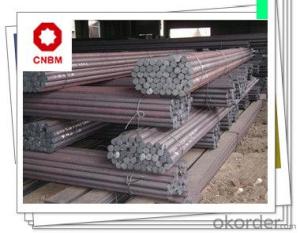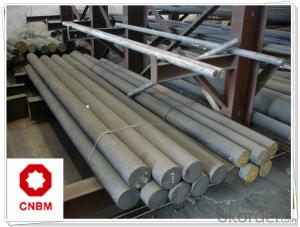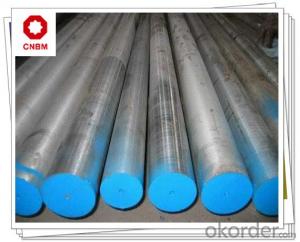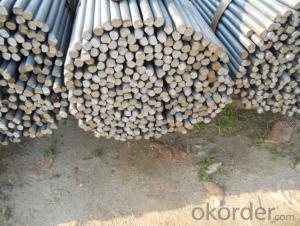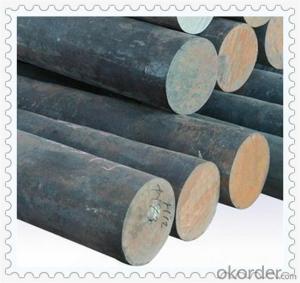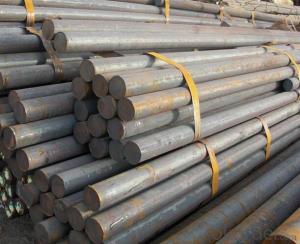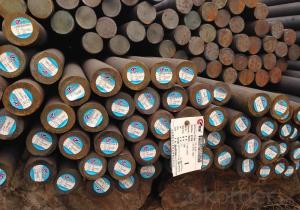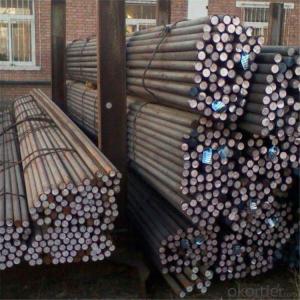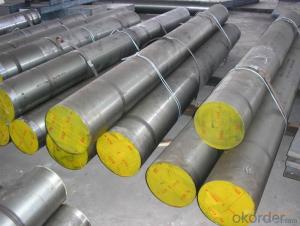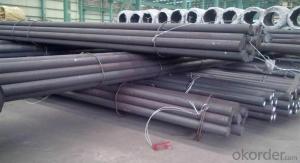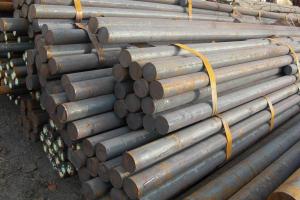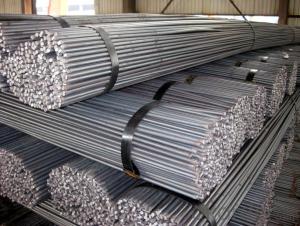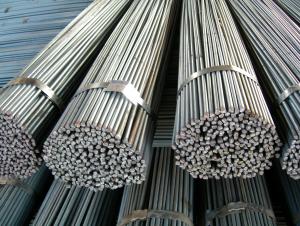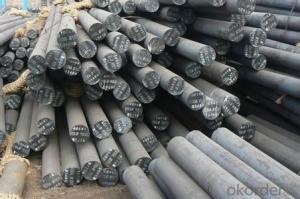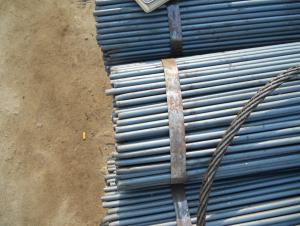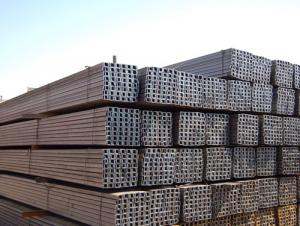Hot Forged QT AISI 4140 Alloy Steel Round Bar
- Loading Port:
- Tianjin
- Payment Terms:
- TT OR LC
- Min Order Qty:
- 100 m.t.
- Supply Capability:
- 50000 m.t./month
OKorder Service Pledge
OKorder Financial Service
You Might Also Like
Specification
Hot Forged QT AISI 4140 Alloy Steel Round Bar
Product Description of Hot Forged QT AISI 4140 Alloy Steel Round Bar
1. Steel grade: ASTM4140, SCM440, 42CrMo, DIN1.7225
2. Length: 6M-12M
3. Diameter: 16mm-300mm
4. Product range: round bar, flat bar, square bar
5. Technique: Hot rolled, forged, cold drawn
Specification of Hot Forged QT AISI 4140 Alloy Steel Round Bar
Material | ASTM4140 | Round bar | Dia(mm) | 16-300mm |
Process | EAF + LF + VD + Forged + Heat Treatment (optional) | Length (mm) | Max 12m | |
Heat treatment | Normalized / Annealed / Quenched / tempered | Flat bar | Thickness(mm) | 8-500mm |
Delivery condition | Hot forged +Rough machined (black surface after Q/T)+ Turned (optional) | Width(mm) | 70-200mm | |
Test | Ultrasonic test according to SEP 1921-84 D/d | Length (mm) | Max 12m |
Chemical Composition of Hot Forged QT AISI 4140 Alloy Steel Round Bar
C | Si | Mn | Cr | Mo | P | S |
0.38~0.43 | 0.15~0.35 | 0.75~1.00 | 0.8~1.1 | 0.15~0.25 | ≤0.035 | <0.04< td=""> |
Photo Show of Hot Forged QT AISI 4140 Alloy Steel Round Bar
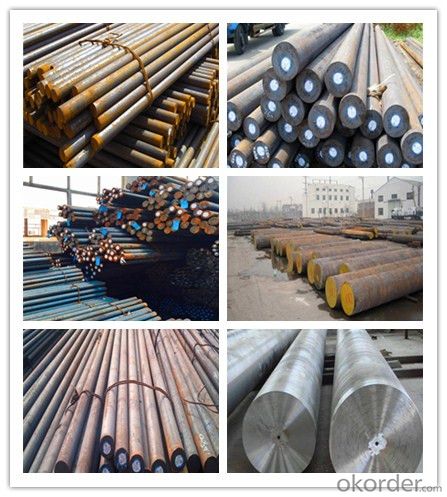
Packing and Delivery:
Packing in bundle package, or as customer's requirements.
Delivery Detail: 45 days after receiving the deposit.
Usage and Applications of Hot Forged QT AISI 4140 Alloy Steel Round Bar
1. Steel round bar is used in a large number of architectural and engineering structures. Or it can be used in construction of plants for the production of steel house frames, high-voltage transmission towers, bridges, vehicles, boilers, containers, ships, etc.
2. And we can use this kind of product on the performance of the mechanical parts if the demand is not very high.
3. Some special material steel round bar can be used for main shaft of steamer, hummer shank, with big section and supper force.
Company Information
CNBM International Corporation is the most important trading platform of CNBM group.
Whith its advantages, CNBM International are mainly concentrate on Cement, Glass, Iron and Steel, Ceramics industries and devotes herself for supplying high qulity series of refractories as well as technical consultancies and logistics solutions.

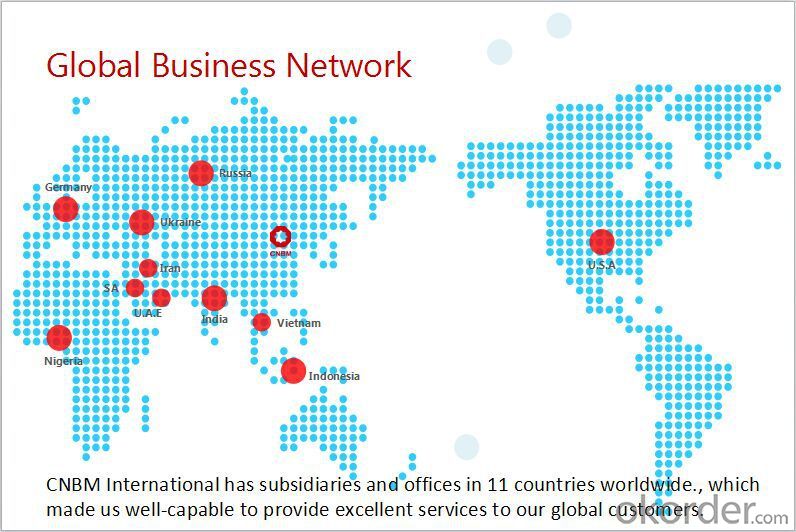
F A Q
1, Your advantages?
professional products inquiry, products knowledge train (for agents), smooth goods delivery, excellent customer solution proposale
2, Test & Certificate?
SGS test is available, customer inspection before shipping is welcome, third party inspection is no problem
3, Factory or Trading Company?
CNBM is a trading company but we have so many protocol factories and CNBM works as a trading department of these factories. Also CNBM is the holding company of many factories.
4, Payment Terms?
30% TT as deposit and 70% before delivery.
Irrevocable L/C at sight.
5, Trading Terms?
EXW, FOB, CIF, FFR, CNF
6, After-sale Service?
CNBM provides the services and support you need for every step of our cooperation. We're the business partner you can trust.
For any problem, please kindly contact us at any your convenient time.
We'll reply you in our first priority within 24 hours.
- Q: Can steel round bars be used for making staircases?
- Yes, steel round bars can be used for making staircases. They provide durability, strength, and a modern aesthetic appeal to the staircase design.
- Q: Can steel round bars be used in the defense industry?
- Yes, steel round bars can be used in the defense industry. They are commonly utilized in various applications such as building military vehicles, manufacturing weapons, and constructing defense structures due to their strength, durability, and versatility.
- Q: Can steel round bars be used in the production of agricultural equipment?
- Agricultural equipment production can benefit from the use of steel round bars. The manufacturing industry often relies on steel due to its strength, durability, and versatility. To withstand the challenges of farming, agricultural machinery like plows, harrows, cultivators, and sprayers require robust components. Steel round bars offer a solution, as they can be used to create axles, shafts, handles, and structural supports for these machines. The high tensile strength of steel ensures that the equipment can handle heavy loads and repetitive use, which are common in agriculture. Moreover, steel can be easily welded, machined, and shaped into various forms and sizes, making it suitable for a wide range of agricultural equipment applications. In conclusion, steel round bars are both reliable and cost-effective for agricultural equipment production.
- Q: Can steel round bars be painted or coated?
- Yes, steel round bars can be painted or coated. Painting or coating steel round bars is a common practice to enhance their appearance, protect them from corrosion, and provide additional functionality. The process typically involves cleaning the surface of the bars to remove any dirt, grease, or rust, and then applying a primer or base coat followed by a topcoat or finish. The type of paint or coating used will depend on the specific requirements of the application, such as the desired color, level of protection, or resistance to environmental conditions. Additionally, certain coatings can provide specific properties like anti-slip, heat resistance, or chemical resistance. Overall, painting or coating steel round bars is an effective way to improve their aesthetics and durability.
- Q: Can steel round bars be used in the manufacturing of home decor?
- Yes, steel round bars can be used in the manufacturing of home decor. They are versatile and can be shaped and welded into various forms, making them suitable for creating furniture, sculptures, and other decorative elements for homes.
- Q: Can steel round bars be used in the agriculture industry?
- Yes, steel round bars can be used in the agriculture industry. They are commonly used in various applications such as constructing farm equipment, fencing, and building structures. Steel round bars are known for their strength and durability, making them suitable for heavy-duty tasks in the agriculture sector. Additionally, steel round bars can withstand harsh weather conditions and resist corrosion, ensuring their longevity and reliability in agricultural settings. Overall, steel round bars are a versatile and practical choice for the agriculture industry due to their strength, durability, and resistance to environmental factors.
- Q: What is the machinability of a steel round bar?
- The ease with which a steel round bar can be shaped, cut, and modified using machining processes determines its machinability. This property measures how easily the steel material can be worked on with tools like lathes, mills, drills, and cutting or shaping tools. Several factors influence the machinability of a steel round bar, including its chemical composition, microstructure, and any heat treatment it has undergone. Elements like sulfur, phosphorus, and lead can either enhance or hinder machinability, while alloying elements like chromium, molybdenum, and nickel can also have an impact. Steel round bars with high machinability are characterized by their ability to be easily cut, drilled, and shaped with minimal tool wear and power consumption. They also produce smooth, precise finishes with minimal surface defects. On the other hand, low machinability steel round bars are more challenging to work with and may require more power, specialized tools, and slower cutting speeds. Considering the machinability of a steel round bar is important when selecting materials for machining applications. Factors like desired cutting speed, tool life, surface finish, and overall machining efficiency should be taken into account. The specific machining operations, such as turning, milling, or drilling, will also influence the choice of steel round bar with suitable machinability. In conclusion, the machinability of a steel round bar is a crucial factor in determining its suitability for various machining processes. Understanding the machinability characteristics of different steel grades can help in selecting the most appropriate material for specific machining applications, ensuring efficient and effective machining operations.
- Q: How do you calculate the moment of inertia of a steel round bar?
- In order to determine the moment of inertia for a steel round bar, one must possess knowledge of the bar's dimensions and properties. The moment of inertia serves as a gauge for an object's resistance to rotational changes. The formula utilized to compute the moment of inertia for a solid cylindrical item, such as a round bar, is as follows: I = (π/4) * D^4, where I signifies the moment of inertia and D symbolizes the bar's diameter. Initially, ascertain the diameter of the steel round bar by means of a caliper or ruler. It is essential to measure the diameter at its broadest point, typically found at the center. Subsequently, input the measured diameter into the formula and calculate the moment of inertia. It is crucial to use the correct units for diameter, such as inches or millimeters, to maintain consistency with the formula. For instance, let's assume the diameter of the steel round bar measures 2 inches. By substituting this value into the formula: I = (π/4) * (2 inches)^4 = (π/4) * 16 inches^4 = 4π inches^4. Therefore, the moment of inertia for the steel round bar with a diameter of 2 inches equals 4π inches^4. It is imperative to recognize that this formula assumes a solid cylindrical shape devoid of any alterations in diameter or hollow sections. If the round bar presents variations in diameter or is hollow, the moment of inertia calculation becomes more intricate and necessitates additional considerations.
- Q: Can steel round bars be used in the food processing industry?
- Yes, steel round bars can be used in the food processing industry. Steel is a common material used in various industries due to its strength, durability, and resistance to corrosion. In the food processing industry, steel round bars are often used for equipment such as food mixers, conveyors, and cutting tools. These bars are typically made from stainless steel, which is a specific type of steel that contains chromium and other elements to enhance its resistance to corrosion and staining. Stainless steel is non-reactive and does not impart any flavors or odors to the food being processed. Furthermore, it is easy to clean and maintain, making it suitable for use in food processing facilities where hygiene is of utmost importance. However, it is important to ensure that the steel round bars used in the food processing industry meet the necessary standards and regulations to ensure the safety of the food being processed.
- Q: What is the difference between a polished and a hot rolled steel round bar?
- The main difference between a polished and a hot rolled steel round bar lies in their manufacturing processes and the resulting surface finish. Hot rolled steel round bars are produced by heating a steel billet or ingot to high temperatures and then rolling it into the desired shape, typically a round bar. This process results in a rough and uneven surface finish with mill scale and imperfections. The hot rolled bars are generally used for applications where surface finish is not critical, such as structural components, machinery parts, and construction materials. On the other hand, polished steel round bars undergo additional processing to achieve a smooth and shiny surface finish. After the hot rolling process, the bars are processed through various grinding and polishing techniques to remove the mill scale, surface imperfections, and achieve a uniform finish. This results in a refined and aesthetically pleasing surface that is suitable for applications where appearance and visual appeal matter, such as decorative items, furniture, and architectural components. In addition to the surface finish, the mechanical properties of the two types of steel round bars can also differ. The hot rolled bars generally have a rougher surface and may exhibit some residual stresses, while the polished bars have a smoother surface and reduced internal stresses. However, the overall mechanical properties, such as strength and hardness, are primarily determined by the grade and composition of the steel used, rather than the manufacturing process or surface finish. In summary, the difference between a polished and a hot rolled steel round bar lies in their surface finish. Hot rolled bars have a rough and uneven surface with mill scale and imperfections, while polished bars undergo additional processing to achieve a smooth and shiny finish. The choice between the two depends on the specific application and the desired appearance of the final product.
Send your message to us
Hot Forged QT AISI 4140 Alloy Steel Round Bar
- Loading Port:
- Tianjin
- Payment Terms:
- TT OR LC
- Min Order Qty:
- 100 m.t.
- Supply Capability:
- 50000 m.t./month
OKorder Service Pledge
OKorder Financial Service
Similar products
Hot products
Hot Searches
Related keywords
